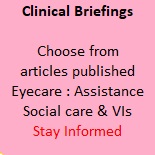General News
DVSA misses opportunity to improve sight standards for motorists
DVSA misses opportunity to improve sight standards for motorists, warns Association of Optometrists
The Association of Optometrists welcomes the Driver and Vehicle Standards Agency’s latest plans to review how sight tests are administered but urges the implementation of fail-safe visual assessment methods
The Driver and Vehicle Standards Agency (DVSA) has published its business plan for 2024, which outlines its intention to consider how sight tests are administered following a public consultation that showed most respondents would like more flexibility in how the test is conducted.
The current test checks that motorists meet the minimum eyesight requirement for driving by reading a number plate from 20 metres.
As part of intended changes to the service, the DVSA has said that it wants to conduct “the eyesight check in the driving test in any level of light – not just good daylight”, and it will “engage with the Driver and Vehicle Licensing Agency’s (DVLA) Medical Panel to ensure that any new procedures meet the current standards.”

Responding to the announcement, Chief Executive of the Association of Optometrists (AOP), Adam Sampson said: “The indication by the DVSA to remove the ‘good daylight’ requirement for sight tests for drivers is concerning as it completely misses the mark. The current system is deeply flawed and falls behind many other countries who require a full sight test to ensure motorists have good enough vision to drive.”
“We have long argued that the way drivers’ vision is assessed needs to change. The number plate test is not a reliable indicator of whether someone can drive safely because it does not check all the relevant aspects of visual function. It is also only carried out once with a driving instructor, meaning someone can pass their test and then never have their vision checked again. The solution is to replace the number plate test with a modern and adequate evaluation process that is carried out by a trained eye health professional, much better placed to assess vision.”
Earlier this year the DVLA updated its notifiable conditions list following open dialogue with the AOP about the administrative burden it could have on patients, optometrists and the DVLA.
Mr Sampson said: “We welcomed the opportunity to work with the DVLA to find a pragmatic solution to the list of notifiable conditions, addressing the very serious concerns we held at that time. Any review of sight tests for driving would be incomplete without improving the current system and requiring drivers to check their vision every time they renew their licence makes good sense to ensure they are meeting the legal standard.
Sight changes are gradual which means that many drivers are unaware that their vision has deteriorated time. The AOP recommends everyone should have their sight tested every two years, or more often if their optometrist recommends it.
The DVSA has confirmed to the AOP that it is in the initial stages of this work and will work closely with the DVLA and stakeholders including the AOP to develop the proposals.
For more information on vision standards for driving, visit: Dont swerve a sight test (aop.org.uk)
























